-
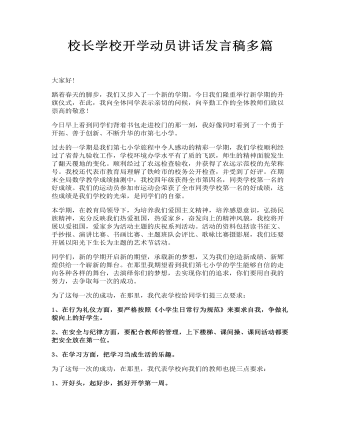
校长学校开学动员讲话发言稿多篇
本学期,在教育局领导下,为培养我们爱国主义精神,培养感恩意识,弘扬民族精神,充分反映我们热爱祖国,热爱家乡,奋发向上的精神风貌,我校将开展以爱祖国,爱家乡为活动主题的庆祝系列活动。活动的资料包括读书征文、手抄报、演讲比赛、书画比赛、主题班队会评比、歌咏比赛摄影展,我们还要开展以阳光下生长为主题的艺术节活动。同学们,新的学期开启新的期望,承载新的梦想,又为我们创造新成绩、新辉煌供给一个崭新的舞台。在那里我期望看到我们第七小学的学生能够自信的走向各种各样的舞台,去演绎你们的梦想,去实现你们的追求,你们要用自我的努力,去争取每一次的成功。
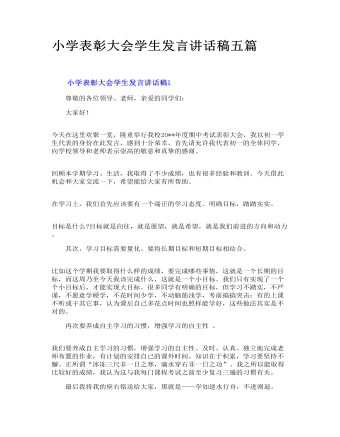
小学表彰大会学生发言讲话稿五篇
比如这个学期我要取得什么样的成绩,要完成哪些事情,这就是一个长期的目标,而这周乃至今天我该完成什么,这就是一个小目标。我们只有实现了一个个小目标后,才能实现大目标。很多同学有明确的目标,但学习不踏实,不严谨,不愿意学硬学,不花时间少学,不动脑筋浅学,考前搞搞突击;有的上课不听或干其它事,认为课后自己多花点时间也照样能学好,这些做法其实是不对的。
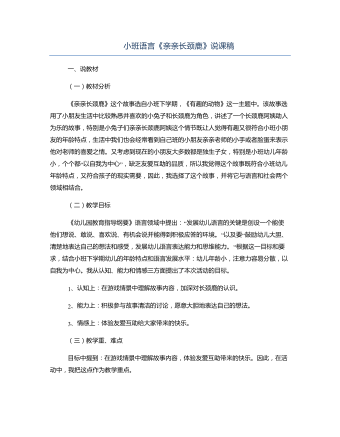
小班语言《亲亲长颈鹿》说课稿
《亲亲长颈鹿》这个故事选自小班下学期,《有趣的动物》这一主题中。该故事选用了小朋友生活中比较熟悉并喜欢的小兔子和长颈鹿为角色,讲述了一个长颈鹿阿姨助人为乐的故事,特别是小兔子们亲亲长颈鹿阿姨这个情节既让人觉得有趣又很符合小班小朋友的年龄特点,生活中我们也会经常看到自己班的小朋友亲亲老师的小手或者脸蛋来表示他对老师的喜爱之情。又考虑到现在的小朋友大多数都是独生子女,特别是小班幼儿年龄小,个个都“以自我为中心”,缺乏友爱互助的品质,所以我觉得这个故事既符合小班幼儿年龄特点,又符合孩子的现实需要,因此,我选择了这个故事,并将它与语言和社会两个领域相结合。
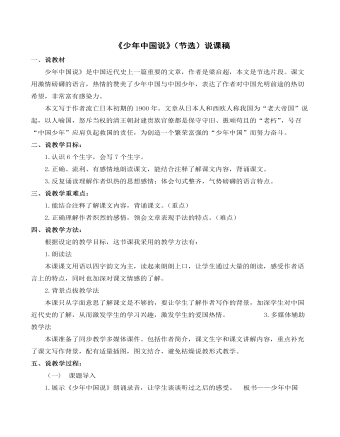
《少年中国说(节选)》说课稿
说教学目标:? 1.认识6个生字,会写7个生字。? 2.正确、流利、有感情地朗读课文,能结合注释了解课文内容,背诵课文。? 3.反复诵读理解作者炽热的思想感情;体会句式整齐,气势磅礴的语言特点。三、说教学重难点:1.能结合注释了解课文内容,背诵课文。(重点)?2.正确理解作者炽烈的感情,领会文章表现手法的特点。(难点)四、说教学方法:? 根据设定的教学目标,这节课我采用的教学方法有:???1.朗读法? ??本课课文用语以四字韵文为主,读起来朗朗上口,让学生通过大量的朗读,感受作者语言上的特点,同时也加深对课文情感的了解。

人教版高中英语必修4A taste of English Humor说课稿3篇
Then I would ask them to think of a funny English or Chinese and tell it to partners. While telling stories, they can use expressions and some acting to help make the story funny. 5 minutes would be given to do this.Those stories they told there will be the material for their writing. Soletting them tell it at first is helpful. And they can make a difference between telling a funny story and writing it down. Generally speaking, it is difficult forstudents to write well because they don’t know what to write and how to write. Asking them to tell their own stories at first can help them come up with what to write.After their telling, I would invite someone to share his/her story with all of us and I would write it down on the blackboard.This example story would be used as a sample to illustrate the format of funny story. Different from a story from teacher or textbook, a story from students can obviously become a interesting material to draw students’ attention.Then I would ask the whole class to put this story into several parts. It might be a little bit difficult for them. So I would ask them to find out whether all the sentences are necessary. After delete some sentences, there are 6 sentences left behind. Then they can easily put them into three parts. After interaction with students, I would teach them the right terms for each part and conclude the format of funny story.This step is the key and difficult point in my lesson. So I mainly usetask-based teaching method in this part and the task for students was divided into several stages. With the separated difficult level, students can find there are usually three parts in writing. They can also learn to write without the unnecessary parts in the process of analyzing. And then I wouldn’t rush to tell them the right terms to them directly. Instead, I would ask them to name them by their own. A confused mind is better for acquiring knowledge.While-writing:Then I would give students 7 minutes to write down this story, without other requirements.With all the preparations in pre-writing, students’ difficulties were cleared. So it would be much easier for them to write down the story within 7 minutes. There are no other requirements because students’ first writing is actually a drafting. It would be revise and edit several times later. Writing, as a skill

人教版高中英语必修3Canada-the true north说课稿4篇
Good afternoon, teachers, It’s my great pleasure to be here sharing my lesson with you.The content of my lesson is Senior English Book 3 Unit 5 Canada —— “The true North”.I’ll be ready to begin this lesson from five parts. Analysis of the teaching material,the teaching methods,the studying methods, the teaching procedure,and Blackboard design.First, let me talk about the teaching material.Part 1 Teaching Material:This unit is about the introduction of Canada. By studying of this unit,we’ll enable the students to learn the geography, population, main cities, and natural beauty, natural resources of Canada. Through the training of the unit, it also requires students to learn some Language skills such as the expressions of position and emotions.So it plays an important part in the English teaching in this book.After studying the teaching material and analyzing the rule of children’s growing of mind,I think the teaching aims are the followings:1.Knowledge objects:(1) make the students learn some new words and phrases(2) make the students understand the content of the lesson.2.Ability objects:(1)To develop the Ss’ abilities of listening, speaking, reading and writing. Especially reading and speaking ability.(2) learn to talk about the characters of Canada in English(3)To train the Ss’ ability of working in pairs.3.Emotion objects:(1)Enable students to understand the characters of Canada..(2)Stimulate Ss to work hard to make China stronger.Part 2 Teaching Methods:I think helping students learn to master new words and phrases and improve the students’ reading and speaking ability is import and the difficult.According to the analysis of the teaching material and the import points and the difficult points,I will use the following teaching methods : question-guiding approach; fast-reading and careful reading; multi-media teaching methods; discussion

人教版高中英语必修4Theme parks说课稿3篇
The oldest and the most popular park in the worldenjoy the exciting activities thereget close to the life-size cartoon characters like Mickey Mouse and Donald Duck Step 3 Pre-reading1.What do you suppose a theme park is ?2.What do you think you can see in a theme park?(1.It is a kind of amusement park which has a certain theme – that the whole park is based on. 2.buildings, castles, statues, rare animals and birds, and so on.) Step 4 Reading ----- Theme Parks –---- Fun and More Than Fun1.Predict : Read the title and the pictures on P. 34 and PredictWhat is the meaning of the title “Theme Park – Fun and more than fun”?(The title means that theme parks are fun to visit, but that they can also be educational and can offer useful information.)2.Skimming Fast read and answer:What activities can we take in a theme park?Amusement park: Bumper car Merry-go-round slide bungee jumping Free-fall rides Horror films Pirate ship Ferris wheel roller coaster3.Scanning Read again and you will find various theme parks are mentioned in the passage . Then what are they ?Theme parks: Sports theme park History theme park Culture theme park Marine or Ocean theme Park Future park Science theme park Disneyland4.Careful reading and find the main idea of each paragraph:THEME PARKS---- entertaining/ educationalPara.1 Traditional parks are places to go for relaxation and to have time away from our busy lives.Para.2 Theme parks are different They’re large and full of things to do, see and buy.Para.3 Theme parks are built around a single idea or theme. One example is a sports park.Para.4 Another kind of theme park is historical more and cultural and can be educational.Para.5 Disneylandwas the first theme park. It is based on the fantasy life and characters of Disney’s films.Para.6 Some examples of educational theme parks include sea world parks and science parks.

人教版高中英语必修3Healthy Eating说课稿4篇
Language learning needs a context, which can help the learners to understand the language and then can product comprehensible output, so computer has the advantages to make the materials attractive.Part 3 Learning MethodsTask-based, self-dependent and cooperative learningPart 4 Teaching ProcedureStep One Lead-in“Interest is the best teacher.” Therefore, at the very beginning of the class, I should spark the students’ mind to focus on the centre topic “the band”. I’ll show some pictures of food to attract their attention and then bring some questions.Question:What kind of food they like?What should go into a good meal?The answers must relate to the diet. After this, the students will be eager to know something about a balance diet and this is the very time to naturally lead the class into Step 2Step 2 Reading for information: skimming and scanning In this step, I use Task-based Language Teaching method, which can give students a clear and specific purpose while skimming and scanning the context.Task 1 General ideaThe students will be asked to just glance at the title and the pictures of the passage, and then guess what they will read in the text. And they’ll be divided into groups of four to have a discussion.The purpose is to inspire the students to read actively, not passively. In addition, the task is to develop the students’ reading skill by making prediction and to encourage the students to express their thoughts in English and cooperate with each other.Task 2 Main idea of each paragraphCooperative learning can raise the students’ interest and create an atmosphere of achievement. Based on this theory, I divide the whole class into 4 groups to skim the whole text and get the main idea of each paragraph.

人教版高中英语必修4Working The Land说课稿3篇
Knowledge objectives:(1) to make Ss grasp the usage of words, expressions and sentence structures: statistics, struggle, thanks to, rid of, some patterns for persuasion, the “ing” form as subject and object;(2)to use learnt knowledge to persuade sb.Ability objectives:(1) to develop Ss’ reading skills(skimming, scanning, word guessing);(2) to improve Ss’ speaking, communicating and cooperating skills.Emotional objectives:to make Ss know the contribution of Yuan,and learn his spirit and his simple life time.Teaching important and difficult points:(1) some words, expressions and sentence structures mentioned above;(2)the content of the text;(3)training their reading and speaking skills.Teaching methods: CLT, TBLT,QT.Learning strategies: CLS, QLS, TBLS.Teaching procedures:Step 1 lead-in: (1) teacher plays a piece of recent news from CCTV about the harvest of the super hybrid rice, and ask students whether they know Yuan or not, and talk about him and his contribution.(2)Brain storm: let Ss describe Yuan in their minds including his appearance, his living condition and so on.Step 2 fast reading tasks:(1)teacher introduces Yuan and super hybrid rice(2)make Ss read the text as fast as possible with questions. Such as: what’s the general ideaof this passage? What’s Yuan’ dream? (skimming and scanning skill)Step 3 intensive reading tasks(1)let Ss read the text silently, find topic sentence of each paragraph and draw the difficult sentences and the knowledge what they don’t understand.(words guessing)(2)teacher and Ss talk about the important words, expressions and sentences together, and ask Ss to retell the content of the text.(summarizing and paraphrasing)(3)teacher summarize this part.(4) read again following the courseware.

人教版高中英语必修5Great scientists说课稿4篇
通过写文章梗概,培养学生综合运用语言的能力,学习用恰当的英语描述科学家的故事。这是本课的教学难点。教师可以使用完形填空的方式来帮助学生整理语篇,从而来降低难度。本课的教学重点的突破方法是:在阅读前,让学生初步了解得出科学观点所需要的基本程序,从而轻松而自然地导入文章的阅读;在阅读过程中,由易到难设计快速阅读和精读的问题,层层推进各种阅读活动,让学生对阅读内容从整体感知到细节理解,最后深层读懂整篇文章,同时加强阅读策略的指导,让每个学生都主动参与课堂教学活动,最终达到提高阅读能力的目的。Step 4 Post-readingGroup Activities四人小组共同合作,在老师的适当指导下,就以下2个问题展开讨论,让学生就所知、所学、所感和所想融入话题,然后抽若干同学代表作小组发言。1. What do you think about John Snow, and what should we learn from him?2. Cholera was 19th century disease, which two diseases are similar to cholera today? Why?

人教版高中英语必修5Making the news说课稿4篇
今天我们来介绍一下必修五第四单元的授课方式。这个单元的题目是Making the news。应该是学生比较感兴趣的话题,学生往往对新闻工作充满好奇,所以我们可以利用这个机会多设计一些师生互动和学生互动,来激发起学习的积极性,提高学习效率。同时我们可以利用这个单元不仅帮助学生掌握语言知识,培养语言能力,同时让其了解新闻工作的重要性,培养起社会智能感。这个单元分为六个课时,它的教学目标是这样的:语言目标是掌握词汇表中的常用单词和短语,掌握倒装句的一些基本用法。 技能目标是能初步掌握约会的基本句型并在真实的场景下正确运用。新闻报道类文章的写作技能。采访的基本规范和沟通技能。情感目标是对新闻报道的客观性和真实性有更好的理解。对新闻记者的职业有更深入的了解,并能体会其工作的重要性。下面我们来介绍一下第一课时的授课方式,第一课的教学目标是这样的第一课时的教学目标语言目标:单词:Occupation, journalist, editor, photographer, curious, personality, enthusiasm

人教版高中英语必修5The United Kingdom说课稿4篇
Teaching Aims:Knowledge 1. Get the students to learn the useful new words and expressions in this section. Aims:2. Let the students learn about how the UK was formed and the four groups of invaders.1. Develop students’ reading ability and let them learn different Ability reading skills. Aims:2. Enable students to learn to talk about the United Kingdom and the Union Jack Emotional 1. Let students know more about the UK2. Develop students’ sense of cooperative learning Aims:Teaching Important Points:1. Let the students learn about the countries of the United Kingdom and the Union Jack2. Get the students to read the passage and know about how the UK was formed and the four groups of invaders.3. Have the students learn different reading skills.Teaching Difficult Ponts:1. Develop students’ reading ability.2. Enable students to talk about the United Kingdom and the Union Jack.3. Let students learn how the UK was formed geographically and historically.Teaching Methods:Showing pictures, asking, exercising, listening, reading etc.Teaching Aids:A computer,a projector and a blackboard.Teaching Procedures: 1) Show a map of the world, ask students the following questions:Where is the UK?What’s the full name of the UK?2) Ask the students work in pairs to do the quiz on Page 9.Do you want to test how many things you know about the United Kingdom? Let’s have a small test.Using the map on P9, students answer the following questions:?How many countries does the UK consist of? What are they??England is divided into three main areas. Do you know what they are? 1) Scanning (10Minutes )Let the students hold the questions asked in pre-reading and read the passagequickly and then let them do the following exercise.Join lines to the right answer.
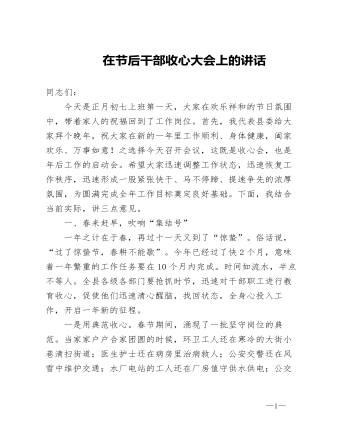
【讲话提纲】在节后干部收心大会上的讲话
一年之计在于春,再过十一天又到了“惊蛰”。俗话说,“过了惊蛰节,春耕不能歇”。今年已经过了快2个月,意味着一年繁重的工作任务要在10个月内完成。时间如流水,半点不等人。全县各级各部门要抢抓时节,迅速对干部职工进行教育收心,促使他们迅速清心醒脑,找回状态,全身心投入工作,开启一年新的征程。一是用典范收心。春节期间,涌现了一批坚守岗位的典范。当家家户户合家团圆的时候,环卫工人还在寒冷的大街小巷清扫街道;医生护士还在病房里治病救人;公安交警还在风雪中维护交通;水厂电站的工人还在厂房值守供水供电;公交汽运司机们还在往返穿梭运送乘客;还有在各个单位坚守岗位值班的人员……想想他们,我们坐得住、等得起吗?他们高度的责任感和敬业精神,就是我们值得学习的身边典范
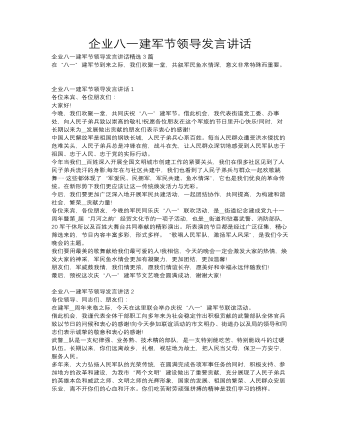
企业八一建军节领导发言讲话
多年来,大力弘扬人民军队的光荣传统,在圆满完成各项军事任务的同时,积极支持、参加地方的改革和建设,为我市“两个文明”建设做出了重要贡献,充分展现了人民子弟兵的英雄本色和威武之师、文明之师的光辉形象,国家的发展、祖国的繁荣、人民群众安居乐业,离不开你们的心血和汗水。你们吃苦耐劳顽强拼搏的精神是我们学习的榜样。“军爱民,民拥军”,军民共建,鱼水情深是我们优良的革命传统。在新形势下我们更应该让这一传统焕发活力与光彩。今后,我们要更加广泛深入地开展军民共建活动。团结协作,共同提高,为构建和谐社会,繁荣经济发展贡献力量!
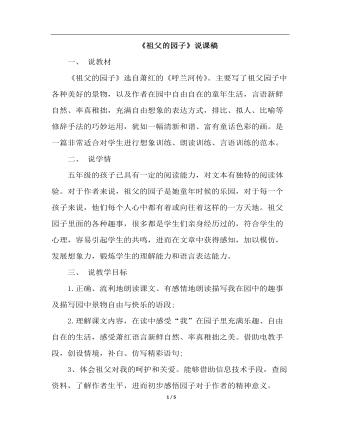
祖父的园子(说课稿)
二、 说学情五年级的孩子已具有一定的阅读能力,对文本有独特的阅读体验。对于作者来说,祖父的园子是她童年时候的乐园,对于每一个孩子来说,他们每个人心中都有着或向往着这样的一方天地。祖父园子里面的各种趣事,很多都是学生们亲身经历过的,符合学生的心理,容易引起学生的共鸣,进而在文章中获得感知,加以模仿,发展想象力,锻炼学生的理解能力和语言表达能力。
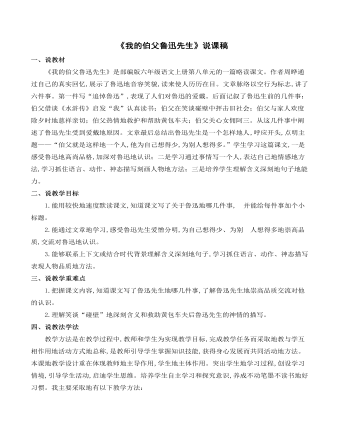
《我的伯父鲁迅先生》说课稿
说教学目标1.能用较快地速度默读课文,知道课文写了关于鲁迅地哪几件事,?并能给每件事加个小标题。? 2.能通过文章地学习,感受鲁迅先生爱憎分明,为自己想得少、为别?人想得多地崇高品质,交流对鲁迅地认识。3.能够联系上下文或结合时代背景理解含义深刻地句子,学习抓住语言、动作、神态描写表现人物品质地方法。? 三、说教学重难点1.把握课文内容,知道课文写了鲁迅先生地哪几件事,了解鲁迅先生地崇高品质交流对他的认识。2.理解笑谈“碰壁”地深刻含义和救助黄包车夫后鲁迅先生的神情的描写。四、说教法学法? 教学方法是在教学过程中,教师和学生为实现教学目标,完成教学任务而采取地教与学互相作用地活动方式地总称,是教师引导学生掌握知识技能,获得身心发展而共同活动地方法。本课地教学设计重在体现教师地主导作用,学生地主体作用。突出学生地学习过程,创设学习情境,引导学生活动,启迪学生思维。培养学生自主学习和探究意识,养成不动笔墨不读书地好习惯。我主要采取地有以下教学方法:? 情景教学法。根据课文描述地情景,适时创设情境,引导学生思考、想象,为激发学生对鲁迅高尚人品地崇敬之情,奠定情感基调。? 讲解法。在学生探究理解地过程中,教师适当补充背景资料、人物介绍、方法指导等,实现教师地主导作用。? 朗读体会法。通过自由读、默读、表演读、感情朗读等,让学生走进人物,体会作者地写作方法,学习文章描写人物地方法。感受文章地思想感情,与作者产生情感共鸣,提高学生地语言感悟能力。? 自主探究与交流延伸相结合学习法。在阅读故事地过程中,学生自主探究学习,感知故事内容,通过与同学、老师交流,不断深化对鲁迅地认识,感受鲁迅地高尚品格。

少让父母为我操心 说课稿
尊敬的各位评委老师,大家好!我说课的题目是小学道德与法治四年级上册《少让父母为我操心》。下面我将从教材分析、学情分析、教学目标与重难点、教法与学法、教学过程、板书设计6个方面进行说课。一、教材分析《少让父母为我操心》是统编教材小学《道德与法治》四年级上册第二单元第5课,共有两话题,本节课学习的是第二个话题《少给父母添麻烦》,主要是引导学生找到如何少给父母添麻烦的方法,旨在引导学生尽力管好自己,少给父母添麻烦,以实际行动体贴父母。二、学情分析学生在一年级下册《我爱我家》和三年级上册《家是最温暖的地方》两个单元的学习中,学生感受到家的温暖和家人的爱,随着学生生活范围的逐步扩大,呈现出一种同心圆放大的趋势。因此,要通过有效的教学,帮助引导学生学会反哺,少给父母添麻烦。三、教学目标与重难点基于教材、学情的分析,以及对小学道德与法治课程的理解,我确定了本节课的教学目标与重难点。教学目标我确定了三个。1.能够做到管好自己。2.愿意从父母的角度考虑问题,能为父母分忧解愁。3.能够照料好自己。教学重点是:愿意从父母的角度考虑问题,尽自己所能做好自己的事、为父母多做事。
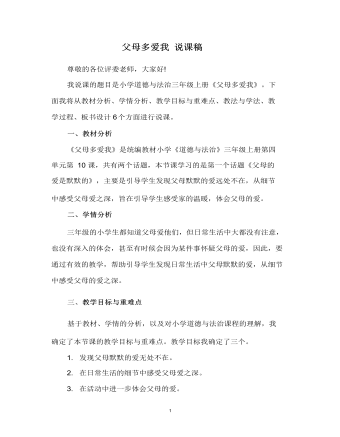
父母多爱我 说课稿
三、教学过程本节课我设计了四个教学环节。 环节一:创设情境,导入新课学生将课前调查到的长辈为自己取名字的故事分享给大家听,教师相机引导到父母的爱这个话题,由此导入新课,板书课题:父母默默的爱。设计意图:激发学生的学习兴趣,引出本节课要学习的内容,为 接下来的学习作好铺垫。环节二:合作探究,学习新课 这一环节我安排了三个活动。 活动一:发现父母默默的爱学生先回忆父母每天都为自己做了些什么,再写在“爱心树”的叶片上,并把每天重复做的事进行标注;然后以小组为单位,把叶片 放在一起比一比,说说有什么发现,谈一谈自己的感受,全班展示交 流,教师相机引导。板书:父母的爱是默默的。设计意图:发现父母默默的爱 活动二:体会父母深深的爱学生先阅读教材第67页阅读角的故事《妈妈喜欢吃鱼头》,教师引导学生讨论,妈妈和外婆真的爱吃鱼头吗?她们为什么会这么做。然后,教师引导学生讲一讲父母疼爱自己的故事,并适时追问: “哪里最让你感动,为什么?”

《感恩父母》说课稿(1)
通过观看视频和段学佳的诗朗诵,初步感悟母爱的伟大, 感悟身边亲情的无处不在。生命,是来自上天的赐予 。 在父母殷切的期盼中,茁壮成长。因而,生命承载了太多的目光和绵绵的情意。你听过这些故事吗?(结合课件演示) 由一组的四位同学汇报搜集的伟大母亲的故事和感恩的故事。有:《孟母三迁》中孟子的母亲为了使孩子拥有一个真正好的教育环境,煞费苦心,曾两迁三地;《地震中伟大母亲》她双膝跪着,整个上身向前匍匐着,双手扶着地支撑着身体,在她的身体下面躺着她熟睡的孩子,在母亲送给孩子的短信中这样写道“亲爱的宝贝,如果你能活着,一定要记住我爱你”。《羊羔跪乳》《乌鸦反哺》反映了动物母子间的亲情,启发学生就连动物都能懂得感恩父母,更何况我们人呢!通过这些感恩故事激发学生心灵上的感触。
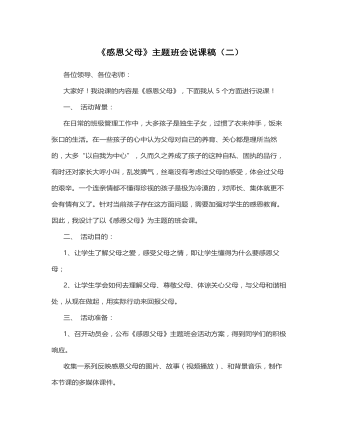
《感恩父母》说课稿 (2)
(你有邹越老师讲到的类似经历吗?请你结合自己的经历谈谈观看感受?)(展示视频重点,引发学生思考)78可怜天下父母心/儿行千里母担忧 /母行万里儿不愁这句话的含义教师启发引导(发动同学们讲自己的亲身故事,谈论观点,从他人的故事散发到自身,从而审视自我问题):讲完了这些故事,我的眼睛湿润了,此时此刻相信每一位同学的心情都无比的沉重,父母亲的爱在儿女面前是那么的无私而博大。设问你是不是一个有故事的人?请大家回想现实生活中父母为我们做过的,你为之动情的一两件事。(教师总结)如果说母爱是水,温柔而恬静,那父爱就是海洋,博大而深沉;现在,就让我们全体起立,用心去写孝道,我们宣誓,把心中对父母深深的感恩告诉他们,然后给我们的爸爸、妈妈一个深深的一鞠躬和最真诚的拥抱(配以音乐)